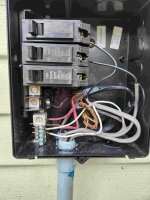jdaddy29
Member
- Location
- Augusta, GA
- Occupation
- Electrical engineer (DC/Automotive)
Hi guys, new here. I may have already learned more in the few threads I've read here than in any of my undergrad classes... thank you for that!
I have a favorite Airbnb unit I stay in when I travel for work. But he's got some serious electrical issues going on-- namely, severe voltage sag (i like "brownouts" although maybe not technically accurate) under heavy load.
My first thought was a bad neutral on the service line, but I decided to investigate more. Here's the story:
Set up:
Rental unit is on a sub panel and the lines are buried from the meter to the subpanel. 65A worth of breakers reside in the sub. Unit has all electric service: mini-split HVAC, electric hot water, and no fewer than 3 motors on the well (I think there's a reverse osmosis filtration system in place). Actually the well pumps may or may not be on the sub, since I couldn't trace their wiring to the source.
Symptom:
Whenever the HVAC and water heater are running simultaneously, the lights and fans dim dramatically inside the unit. I measured voltage as low as 109.0 VAC at a receptacle during these events. No breakers ever tripped at any point during my stays. On the second night, the transformer at the street blew up, resulting in a street-wide service outage lasting overnight. Maybe coincidence? Whatever the case, the unit's problems persisted after electrical service was restored.
Investigation:
Caveats: I only had access to the unit sub panel. The meter box was locked and the service lines were fully enclosed in conduit up the 20ft pole. The breaker box was inaccessible as the main house was locked. The lines to the sub appeared to be coming off the meter/pole rather than from the house.
I'm attaching a few photos from the sub. It looks to me like the owner ran a single leg of 120 to the unit sub; I didn't measure 240 anywhere inside the sub. I confirmed the water heater was 120, can't remember explicitly checking the HVAC. Only 3 wires though... guess that's not definitive.
Again, frequent brownouts at the unit with low voltage readings of 109 during.
Many photos here. I hope it's okay to post this way....couldn't find an add photo button:
https://drive.google.com/drive/folders/10evW_kr6Sh7hb1mVz-qi_yjzcjiU2DTP
Conclusive, or additional information needed?
I've read on this forum about the importance of load balancing. If he's pulling the whole unit load from one leg of 120, about 65A, does that constitute a serious imbalance? Would that explain the voltage sag? Does this appear to be the case from the photos of the sub panel?
Can I draw any conclusions at this point or is it still ambiguous based on limited information gathered?
How great is the danger to life, limb, or property in this case?
Thanks for your advice, y'all! I'm not making any money in this, BTW, it's purely a learning/curiosity thing for me at this point.
I have a favorite Airbnb unit I stay in when I travel for work. But he's got some serious electrical issues going on-- namely, severe voltage sag (i like "brownouts" although maybe not technically accurate) under heavy load.
My first thought was a bad neutral on the service line, but I decided to investigate more. Here's the story:
Set up:
Rental unit is on a sub panel and the lines are buried from the meter to the subpanel. 65A worth of breakers reside in the sub. Unit has all electric service: mini-split HVAC, electric hot water, and no fewer than 3 motors on the well (I think there's a reverse osmosis filtration system in place). Actually the well pumps may or may not be on the sub, since I couldn't trace their wiring to the source.
Symptom:
Whenever the HVAC and water heater are running simultaneously, the lights and fans dim dramatically inside the unit. I measured voltage as low as 109.0 VAC at a receptacle during these events. No breakers ever tripped at any point during my stays. On the second night, the transformer at the street blew up, resulting in a street-wide service outage lasting overnight. Maybe coincidence? Whatever the case, the unit's problems persisted after electrical service was restored.
Investigation:
Caveats: I only had access to the unit sub panel. The meter box was locked and the service lines were fully enclosed in conduit up the 20ft pole. The breaker box was inaccessible as the main house was locked. The lines to the sub appeared to be coming off the meter/pole rather than from the house.
I'm attaching a few photos from the sub. It looks to me like the owner ran a single leg of 120 to the unit sub; I didn't measure 240 anywhere inside the sub. I confirmed the water heater was 120, can't remember explicitly checking the HVAC. Only 3 wires though... guess that's not definitive.
Again, frequent brownouts at the unit with low voltage readings of 109 during.
Many photos here. I hope it's okay to post this way....couldn't find an add photo button:
https://drive.google.com/drive/folders/10evW_kr6Sh7hb1mVz-qi_yjzcjiU2DTP
Conclusive, or additional information needed?
I've read on this forum about the importance of load balancing. If he's pulling the whole unit load from one leg of 120, about 65A, does that constitute a serious imbalance? Would that explain the voltage sag? Does this appear to be the case from the photos of the sub panel?
Can I draw any conclusions at this point or is it still ambiguous based on limited information gathered?
How great is the danger to life, limb, or property in this case?
Thanks for your advice, y'all! I'm not making any money in this, BTW, it's purely a learning/curiosity thing for me at this point.

